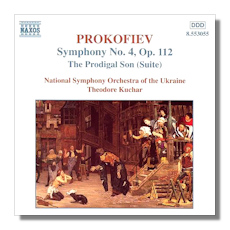
The Internet's Premier Classical Music Source
Related Links
- Prokofieff Reviews
- Latest Reviews
- More Reviews
-
By Composer
-
Collections
DVD & Blu-ray
Books
Concert Reviews
Articles/Interviews
Software
Audio
Search Amazon
Recommended Links
Site News
 CD Review
CD Review
Serge Prokofieff

Orchestral Music
- The Prodigal Son, Op. 46
- Symphony #4, Op. 112
National Symphony Orchestra of Ukraine/Theodore Kuchar
Naxos 8.553055 76:15
Summary for the Busy Executive: Terrific #4. Very musical L'enfant.
Diaghilev died the season of Prokofieff's Prodigal Son (L'Enfant prodigue), thus ending probably the greatest modern era of ballet. Diaghilev not only brought in higher-class music than normal for the genre (Giselle, for example, constitutes a long evening before the stereo), he also made ballet a collaboration of poets, painters, and composers. In addition to Prokofieff, Diaghilev commissioned Debussy, Stravinsky, Ravel, Falla, and Poulenc. Benois, Bakst, and Picasso were among those who designed costumes and sets.
For some reason, Diaghilev had a penchant for staging Biblical stories. Prokofieff did not stand alone. Richard Strauss, for example, wrote the kitschy Josephslegende, one of his weakest scores. Indeed, such ballets became so chic that Vaughan Williams was moved to satirize the trend as, "My dear! Have you seen God at the Russian Ballet?" Vaughan Williams himself wrote Job, but avoided the Ballets Russes, fearing what would become of the production, and in any case, he was inspired more by the Blake illustrations than the Biblical story itself. Prokofieff, on the other hand, avoids the taint of the trendy, mainly because of his splendid gifts for drama and characterization. In the two main characters, the father and the son, you don't get church-pageant pasteboard, but portraits with real psychological depth. The type of music the story drew from Prokofieff seems a run-up to the masterpiece Roméo and Juliet, seven years later.
However, unlike Roméo and Juliet, Prodigal never became a ballet hit, but its music long ago found its way into the orchestral repertoire, mostly as a suite. Although Naxos labels this item as the suite, this is pretty near the complete score, just from the timings alone, since the suite runs about 20 minutes less. According to Keith Anderson's liner notes, the account leaves out only one section of the final scene.
During the composition of the ballet, Koussevitzky asked the composer to write something for the Boston Symphony Orchestra's 50th season. This event yielded more music of astonishingly high quality than any occasion since The Triumphs of Oriana. The crop included Honegger's Symphony #1, Stravinsky's Symphony of Psalms, Ravel's Piano Concerto in G, Hindemith's Concert Music for Brass and Strings, Gershwin's Second Rhapsody, Roussel's Symphony #3, and Hanson's "Romantic" Symphony #2, as well as Prokofieff's Symphony #4, Op. 47. In order to meet the deadline, Prokofieff told a Koussevitzky that he planned to work in themes from Prodigal. Koussevitzky worried about the result, but Prokofieff assured him that he would extend the material to create a genuine symphonic structure, rather than a set of dances. Not satisfied with the result or its lukewarm reception, he revised the work as his Op. 112 in 1947. I'd argue that if you didn't know its balletic origin, you wouldn't guess it. Kuchar performs the revision. You can also get the original from a couple of sources. Rostropovich has recorded both versions. Compared to the previous two symphonies, it shows clearer architecture and cleaner scoring. In fact, it shares more with the Fifth than with the Third in its outlook.
The first movement, a fairly straightforward sonata, beings with a noble introduction, newly-composed, followed by an allegro based on the dance depicting the youth's riotous living. This leads to a lyric second subject, original to the symphony. A lengthy development section ensues until a recap. Prokofieff kept his promise to Koussevitzky.
The material of the tender slow movement comes from the ballet's final scene – the father's love and the son's remorse – but the composer mines far deeper to produce one of his most expressive symphonic movements. The languorous theme of "the seductress" gets thoroughly transformed into a third-movement allegretto scherzo and trio. Again, Prokofieff deepens the material from the outwardly dramatic to inner psychology. Most of the matter comes from the son's music in the ballet opening, but again Prokofieff has significantly varied and extended his base. It leads to a perky march, returns to the opening material, and winds up with a coda based on the symphony's first subject group. The "Classical" Symphony and this one count as the two best of Prokofieff's non-Soviet symphonies.
Kuchar does wonderfully well with both scores. I may prefer the more dramatic qualities of Jurowski on CPO, but Kuchar's not all that far behind. The Fourth counts as one of the best out there and a steal at Naxos's price. The sound improves on the disc containing the Third – less "live" and echo-y. However, there's one glitch during the seductress's scene in Prodigal. Somebody – perhaps Kuchar, perhaps a civilian who wandered in – exclaims something in the excitement of the moment. At first, I thought it my next-door-neighbor outside my window, but I always heard it at the same spot in the score. Nevertheless, it didn't ruin my enjoyment.
Copyright © 2011, Steve Schwartz.





















